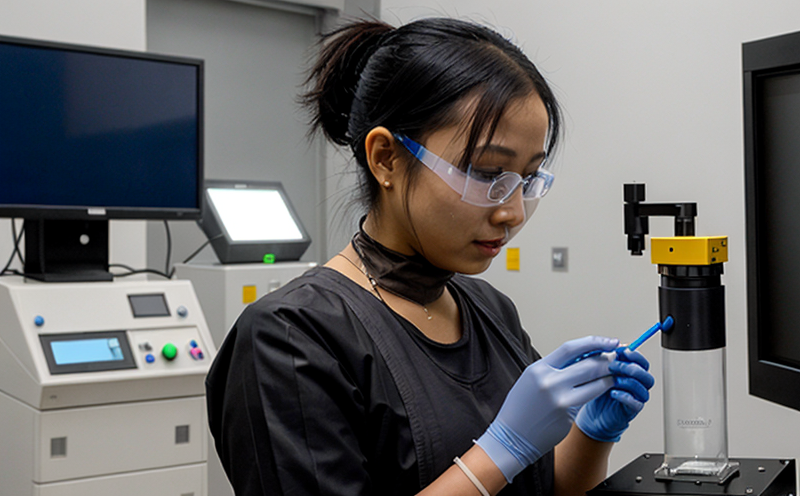OECD TG 202 Daphnia Immobilization Test with Nanoparticles
The OECD TG 202 Daphnia Immobilization Test is a pivotal method for assessing the toxicity of nanomaterials in aquatic environments. This test, as defined by Organization for Economic Co-operation and Development (OECD) guidelines, evaluates how nanoparticles affect the survival and behavior of Daphnia magna, a commonly used freshwater crustacean in toxicological studies. The primary goal is to determine whether exposure to nanomaterials leads to immobilization or death among test specimens.
The OECD TG 202 test is particularly significant for industries involved in the development and production of nanomaterials, including those in electronics, cosmetics, pharmaceuticals, and environmental remediation. Regulatory bodies worldwide are increasingly focusing on ensuring that new technologies do not pose unintended risks to ecosystems. This test provides a standardized approach to evaluate potential impacts without relying solely on traditional toxicity tests.
The test protocol involves exposing daphnids to a suspension of nanomaterials under controlled conditions. Observations are made regarding the behavior and survival rates of the daphnids over time. The key parameters measured include mortality, immobilization duration, and growth inhibition. These metrics help researchers understand the potential environmental risks associated with various nanoformulations.
The OECD TG 202 test is typically conducted in compliance with ISO standards for nanotoxicology testing to ensure consistency and reliability across different laboratories. Compliance officers and R&D engineers rely on this standardized approach to meet regulatory requirements and ensure product safety before market release.
One of the critical aspects of this test is the precise preparation of nanoparticle suspensions. The size, shape, and surface properties of nanoparticles play a significant role in their interaction with aquatic organisms. Therefore, thorough characterization using techniques like transmission electron microscopy (TEM), dynamic light scattering (DLS), and zeta potential measurement are essential before conducting the test.
The test setup involves maintaining daphnids in an aquarium under defined conditions for a period of 48 hours or longer, depending on the specific protocol. During this time, detailed observations are recorded to assess any signs of immobilization or mortality. The data collected is then analyzed according to predefined criteria outlined by OECD guidelines.
The OECD TG 202 test is not only valuable for regulatory compliance but also for advancing scientific understanding of nanomaterial behavior in aquatic ecosystems. By providing actionable insights, this test helps researchers and industries develop safer products while minimizing environmental impact.
| Parameter | Description |
|---|---|
| Mortality Rate | The percentage of daphnids that die during the exposure period. |
| Immobilization Duration | The time taken for daphnids to become immobile after exposure. |
| Growth Inhibition | The extent to which nanoparticle exposure affects daphnid growth. |
| Reproductive Success | The number of offspring produced by surviving daphnids compared to control groups. |
Understanding these parameters is crucial for assessing the environmental safety of nanomaterials. Regulatory bodies such as the European Chemicals Agency (ECHA) and the US Environmental Protection Agency (EPA) often require compliance with OECD TG 202 when evaluating the potential risks associated with new nanomaterial formulations.
For industries, conducting this test ensures that their products meet stringent environmental standards, thereby reducing the risk of legal challenges and enhancing public trust. This standardized approach also aids in continuous improvement by identifying areas where product formulations can be optimized for better environmental performance.
Applied Standards
The OECD TG 202 Daphnia Immobilization Test is based on internationally recognized standards that ensure consistency and reliability in nanotoxicology testing. The primary standard used is the OECD Guideline for Testing of Chemicals, specifically OECD TG 202 (Daphnia magna acute toxicity test). This guideline provides detailed procedures and criteria to conduct the test accurately.
Other relevant international standards include ISO 17289:2015, which specifies methods for the characterization of nanomaterials, particularly in relation to their environmental impact. These standards are critical for ensuring that the results from the OECD TG 202 test can be compared across different laboratories and countries.
Compliance with these standards is essential for industries involved in nanotechnology research and development. It ensures that all tests conducted meet the highest scientific and regulatory benchmarks, thereby enhancing trustworthiness and credibility of the findings.
Benefits
The OECD TG 202 Daphnia Immobilization Test offers several advantages for industries working with nanomaterials:
- Regulatory Compliance: Ensures that products meet stringent environmental regulations.
- Environmental Safety: Provides insights into the potential risks of nanomaterials to aquatic ecosystems.
- Product Optimization: Helps identify areas for improving product formulations and reducing environmental impact.
- Enhanced Credibility: Increases trustworthiness by meeting international standards and guidelines.
The test is particularly beneficial for R&D engineers looking to innovate while ensuring safety. It provides a clear pathway for developing safe nanomaterials that can be used in various applications without compromising environmental integrity.
Use Cases and Application Examples
This test is widely applied across industries to evaluate the potential risks of nanomaterials. Here are some specific use cases:
- Electronics Industry: Evaluating the environmental impact of nanoparticles used in electronic components.
- Cosmetics Industry: Assessing the toxicity of nano-sized ingredients in personal care products.
- Pharmaceuticals: Understanding the effects of nanomaterials on aquatic life before clinical trials.
- Environmental Remediation: Testing nanoparticles used for water purification to ensure they do not harm aquatic organisms.
The following table summarizes some key points from various use cases:
| Industry Sector | Use Case | Main Outcome |
|---|---|---|
| Electronics | Evaluating nanoparticle toxicity in electronics manufacturing processes. | Identifying safe exposure levels and optimizing production. |
| Cosmetics | Assessing nano-sized ingredients for skin care products. | Determining biodegradability and potential environmental risks. |
| Pharmaceuticals | Evaluating nanoparticle safety in drug development. | Avoiding unintended effects on aquatic ecosystems during clinical trials. |
| Environmental Remediation | Testing nanoparticle effectiveness for water purification. | Ensuring safe and effective use without harming the environment. |
The test is also valuable for quality managers in ensuring that their products meet environmental standards. It helps procurement teams select suppliers who prioritize sustainable practices, thereby contributing to a more environmentally responsible supply chain.





